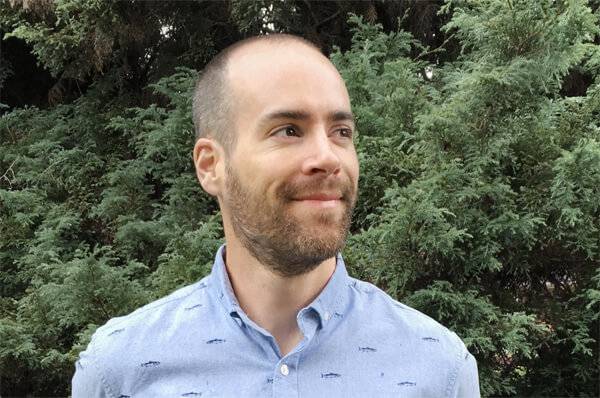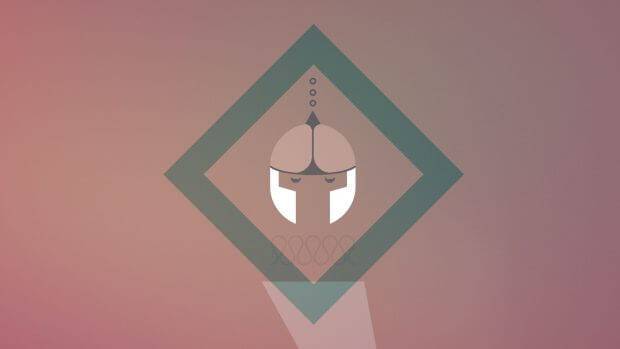An interview with Eoin Duffy (‘I Am Here’/’The Missing Scarf’)
UPDATE 06/11/2017 – Eoin Duffy’s I Am Here is now online in full
Following his 2013 debut short film On Departure, made with the assistance of the Irish Film Board, Vancouver-based Irish director Eoin Duffy‘s The Missing Scarf wowed audiences internationally in 2014 with its nuanced, design-informed approach to timing and composition matched with an intensely charming story narrated by the incomparable George Takei. Having previously shared his insight into the process of self-marketing as a contemporary filmmaker, Eoin has been gracious enough to shed more light on his filmmaking process, including his latest short film project (his first produced in association with the National Film Board of Canada) I Am Here (Je suis ici). Starring veteran Canadian performer Nicholas Campbell, this latest film showcases Eoin’s unique design style at its most atmospheric and adventurous, and will screen at Montreal’s Sommets du cinéma d’animation this week.
You have a quite succinct bio on your website – ‘Writer and director of animation’ – I assume there’s more to that story…
(Laughs) Yeah, I guess I have to get better about talking about myself! My background is in graphic design, I graduated in 2006, started working in web design and then messed around with programs like Flash, teaching myself animation over the years. Then three or four years ago I applied for a grant from the Irish Film Board and that was my jump into animation.
So you were entirely self-taught on the animation side of things?
The motion design, yeah. I guess it isn’t a major achievement; my stuff is very simple, extremely minimal design, the animation equally so. When I do need to do more complicated stuff I love teaming up with character animators or people who can do motion better than me. But for the most part one kind of feeds of the other – my abilities are pretty small so then the end result is pretty small and minimal.
I guess I probably spend more time on the timing than high-production values. Just one little sequence or transition I could spend anything up to a day just slightly easing the timing between certain little crossovers. I’m not sure where that came from or where I learned it or what it’s based in, I just thought it was me just being finicky (laughs). I played music for years and years, I was in bands, so I think maybe it comes with the music thing, just getting that timing, almost a beat to a script. Even when I write scripts I keep the sentences and the paragraphs all roughly the same size and length so it kind of has beat to it or a pattern to it. So yeah, I guess timing is key for me.
Was On Departure the film that you were given the grant for?
Exactly, I kind of used that as a catalyst to get into animation. I presented the boards and some little experiments I’d done in animation to the Irish Film Board, who had massive balls and took a massive gamble on me – “Here’s a bunch of cash, go and make your first animation”! So from that I made On Departure, that was the very first film.
So were you then working with other people on that one or was that kind of a solo effort?
Well, they’re primarily solo efforts, even with The Missing Scarf. My go-to thing that I tell a lot of animators starting out is to pump your entire budget into audio. That’s what I did with all these films, I got the best composers, voiceover artists, sound designers, so that left little-to-no budget for animation, so I just whacked out all the visuals on a laptop. It’s hard to tell animators that they’re just 20% of the process, that it’s primarily an audio experience, so I think visuals play a smaller role than audio. So yeah, pump all your money into audio and worry about visuals later.
I think the best evidence I’ve ever seen of that is there’s an amazing video on YouTube of some kid who re-enacted the entire movie Toy Story with actual toys!He just uses the audio of the feature film, but frame for frame he recreated the whole film – the thing is, it’s very watchable, more so than very polished animation, and it’s all down to that audio base being very strong, and you can just tack on any visual. So while my visuals seem very simple and easy I think yeah, the complexities are in the audio.
Was The Missing Scarf made under similar funding circumstances as On Departure?
Yeah, the exact same grant through the Irish Film Board’s Frameworks program. Halfway through On Departure I got the idea for The Missing Scarf, so I applied for the grant and went through the exact same process. The Irish Film Board are really nice people to work with and there are very few funding bodies that just completely hand you the film at the end and let you do what you want with it, where you own all the rights, I think that’s very rare.
So with The Missing Scarf I teamed up with a good friend, a fellow designer who was a producer on the film, Jamie Hogan. He was a massive help in pushing the film to be what it is today.
And you and Jamie still work together on commissioned projects?
Yeah, that’s what we’ve tried to do. I kinda got sucked into this latest NFB film for the past few months, but I’m hoping to jump back on that and connect up with Jamie. He’s really good about pushing the script to be the best possible script it can be; with The Missing Scarf, say, I took the script through like 80% of what it was and he was like “No we need to get an editor involved and do 20 rewrites, we need to push it to that extra level”. So he’s a good pushing force and I’m excited to team up with him again.
It’s a really solid script, had you had much experience writing before?
To be honest, no – The Missing Scarf is the first script I ever wrote. On Departure and all the earlier work just had no dialogue simply because it was the easy option, I never knew anything about recording voiceover artists. Even recording George Takei for The Missing Scarf was my first time in a voice-acting studio, I was hugely out of my depth! So I’m glad it came through.
There’s almost a folksiness to the story, was there any sort of conscious reference to stories – or fables – you’d read as a kid?
No direct reference, but I’m sure there’s something there. Because it’s like a kid’s storybook, it kinda sets you into these false sense of security just so we can slap you in the face.
So right now you’re based in Vancouver, was it mainly working with the NFB project that prompted that move or was it something else?
No, my wife is from Vancouver, we met years ago just touring around and toured around for another couple of years and have just ended up back here. So yeah, as good a reason as any!
So when did the relationship with the NFB start?
It was maybe about two years ago I first approached them, or a year and a half ago. I’d just shot them over an idea and said “What’s the process of working with you?”, and they jumped on it. The NFB has offices all over Canada and they’re reigniting their animation office here in Vancouver, so it was kind of the perfect storm, they really wanted to push animation in Vancouver. Then I just happened to approach them at that exact time, when The Missing Scarf was exploding, so they jumped on board and were happy to team up.
Did their approach to the production of the film differ in any major way to what you’d been used to before?
Very much so. My only experience is with the Irish Film Board, where maybe 40% of our time went into paperwork; I’ve done commercial projects on a much, much larger scale, but I’ve never had a project have so much of my time eaten up by the amount of paperwork that they require to justify giving out little lump sums of budget. With the NFB they just say “Go for it, we’ll handle the budget, we’ll be the producer, you just be creative and do it” but then the flip side is the IFB hands you the film and you own all the rights at the end of it, but the NFB work like a production company where they’re hiring you to make a film and at the end of it they 100% own the film and then they decide how to distribute it, what festivals to enter, when to put it online, everything.
So was this an idea that was fully-formed when you presented it to them, or did it develop as it went?
Yeah, it was pretty much fully-formed, I presented a slight tweaking of the script, but the thing that wasn’t fully formed were the visuals, so with them it took months and months of designing. The NFB weren’t intrusive at all, but anytime they did step in and give a small bit of advice (which you weren’t obliged to take on), it was good advice.
Did they put together any kind of team for you? Back to your earlier point, certainly a lot of work has gone into the audio with this film, for example.
Yeah, they really helped out. We paused production for six months because we’d approached Paul Giamatti about doing the voiceover, who’d said yes, but there were huge complications in hiring an American actor for a Canadian funding body and it didn’t really happen. So then the NFB suggested Nicholas Campbell who nailed the script, he was amazing! He’s a TV actor here in Canada, a really interesting character. Then I suggested John Black, a Toronto-based sound designer and they suggested Menalon, a Montreal-based composer duo, who were amazing as well. So yeah, we got that amazing stack of audio people who made my job super easy once again.

Eoin Duffy (Photo ©Kristina Shu)
The opening part has some very adventurous visuals – were they at all informed by the sound mix or was it more traditionally animated first with a sound mix specific to the visuals?
Yeah, it was more traditional – John was just throwing me ideas, so we didn’t really have the sound design locked down, but from that we imagined this character transmitting a kind of distorted signal through space which isn’t really picked up on. That idea of a distorted, unheard signal was where the visuals came from. With the sound design he got pretty experimental, he got these specialised mics he could put right up to, say, an old CD-Rom and he was able pick up something to do with, I think, the magnetic fields of the electronics. The end result was amazing!
Is the ‘reveal’ of the film – which I don’t want to spoil, so I’ll tread cautiously – based on real-life observation?
For me, I guess it was a bit. It’s hard to talk about it without giving everything away, but I like the idea of pulling everybody back to reality. It wasn’t based on any one event but we’ve all kind of known that character, seen that character somewhere, so maybe they have more to tell us than we think. There are definitely complexities going on there that we just don’t know a lot about, I guess this film slightly touches off that.
You also do a lot of microshorts, are these for the most part entirely personal and done in your free time?
Yeah, just 100% my free time, I’ll go onto Freesound or download some audio samples and then I usually have some type of idea in my mind. I try to give myself a timeline, from idea to concept to script to storyboard to animation to sound design to getting it out there, I try and do it all in like ten hours or something, just do it super, super quick. Like how Picasso’s sketchbook is more interesting than a lot of his finished art, I love just pumping out something really quick for the sake of it. If you spend too much time polishing it you might wreck the idea, or shave something off. I just like the idea of quick animated sketches, I want to do more but I seem to be running out of time these days.
Is there anything you’re working on at the moment that you’d like to talk about?
Yeah, I’m working on two other short films and another project for TED Ed, and then a couple of applications for funding for other short films. So yeah, trying to split myself 50-50, chasing client work and doing short films. I guess if you do more, or completely go the short film route, for one thing it’d be hard to make a living and the other thing is you don’t really push yourself outside of your comfort zone. With client work they can throw these completely random concepts at you and you have to come up with a solution, more so than what you’d do on your own.
I Am Here will screen this week at Montreal’s Sommets du cinéma d’animation as part of International Competition 1, which runs Thursday 24th 7pm and Saturday 26th 9pm at the Cinémathèque québécoise. Eoin will also be part of the film funding panel discussion Money and Eyeballs on Thursday 24th 3pm.
See more of Eoin Duffy’s work at eoinduffy.me



